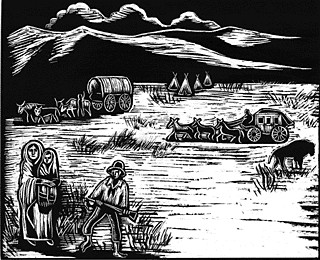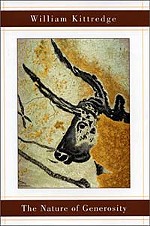Book Review: Readings
Larry McMurtry
Reviewed by Mark Busby, Fri., Dec. 29, 2000

Boone's Lick: A Novel
by Larry McMurtrySimon & Schuster, 287 pp., $24
Almost three years ago, Larry McMurtry, Texas' foremost novelist for almost 40 years, declared that he would write one more novel and then be done with writing fiction. With Duane's Depressed (1999), he completed the Thalia trilogy that began with The Last Picture Show (1966) and moved through Texasville (1987), and he apparently finished off his career as a fictionist. His forays into nonfiction produced two memoirs, Walter Benjamin at the Dairy Queen (1999) and Roads (2000), and a short biography, Crazy Horse (1999).
But he couldn't do it, couldn't stay away from the work that's driven him all these years. Tracing the story of Crazy Horse pointed him perhaps down the path of his newest novel, Boone's Lick, for Crazy Horse appears here as an unnamed Indian who playacts having a lame horse and leads Colonel William Judd Fetterman and 80 cavalrymen into a trap on December 21, 1866. This event entered history as the "Fetterman Massacre," and it becomes the linchpin of this novel, where McMurtry returns to his fictional examination of the 19th-century American West.
While there are echoes of McMurtry's masterpiece, Lonesome Dove (1985), this new novel is more reminiscent of Anything for Billy (1989) and Buffalo Girls (1991), effectively told stories but less ambitious books. Like many of McMurtry's other works set in the 19th century, Boone's Lick assembles a cast of effectively drawn, often eccentric, fictional characters who eventually set out on a journey in the historical West, where they meet up with McMurtry's versions of historical characters like Colonels Fetterman and Carrington and Wild Bill Hickok, who makes a cameo appearance in the first part of this book before disappearing.

The primary fictional characters are members of the Cecil family of Boone's Lick, Missouri (the home of Kit Carson, who does not appear here). Fifteen-year-old Shay, whose voice clearly recalls another Missouri youth, Huckleberry Finn, tells their story. Shay's mother, Mary Margaret, gets tired of waiting for her wayward husband, Dick, to return from another of many freight-hauling trips to the West during their 15-year marriage, so she gathers her clan, which includes Shay's siblings, G.T., Neva, and baby Marcy; Shay's uncle, Seth; his Grandpa Crackenthorpe; and Mary Margaret's wayward half-sister, Rose. They set out by riverboat and wagon to travel from Boone's Lick to Fort Kearny in Wyoming territory to search for Dick.
Along the way they increase their entourage when they meet a barefooted priest named Father Villy and an Indian named Charlie Seven Days, who recalls other admirable McMurtry fictional Indians such as No Ears from Buffalo Girls and Famous Shoes from Streets of Laredo. To balance such villainous Indians as Blue Duck from Lonesome Dove, McMurtry has created full and sympathetic Indian characters who grapple with both personal difficulties and the reality of the large events at the end of the frontier -- positive affirmations of Indian culture within McMurtry's typically elegiac view of the passing West. Charlie is similar to these characters, but he is never fully fleshed out in this novel of attrition, where many of the interesting secondary characters like Charlie die, wander off, or just disappear without explanation before novel's end.
The most forceful character is clearly Mary Margaret. Over the years McMurtry has been recognized for his ability to create interesting women characters like Aurora Greenway in Terms of Endearment, and Mary Margaret Cecil fits the category of spunky, determined women. But this is more Shay's story, and much of the appeal of this novel comes from the ease with which McMurtry writes from the point of view of a teenage boy. Here, for example, Shay, like young Sam Clemens on the Mississippi, tells of learning to read the Missouri River from Indian Charlie:
The surface of the river was never steady for long; there would always be little waves, or a fish would jump and go back down with a splash, or a waterbird would skim the surface and disturb the water. Even a water bug could do it, skipping along. But, by looking close, I finally did see the ripple Charlie was talking about, just a little V where the water edged around something hidden just underneath it.
It's a supple move for McMurtry to shift from concentrating on an aging Duane Moore in Duane's Depressed to the youthful experiences of Shay Cecil. In fact, Shay's initiatory experiences carry the weight of this story more than Mary Margaret's journey to find her husband, which functions mainly as the reason to get them going on the journey west rather than being the primary story. Shay and the other travelers leave the relative calm of Missouri for the fearful crossings of raging streams, the sudden appearance of grizzly bears, and the sheer terror of Indian attacks (including the physical mutilation of victims). Shay's awareness of the random violence of the West is punctuated by his recognition of the awesome beauty of its vastness. Additionally, he begins to realize that the buffalo and beaver are disappearing and that Indian cultures and the openness of the West are being diminished as civilization advances, a steady stream of pioneers journeying along the "Holy Road."
Boone's Lick, then, is another of McMurtry's ambivalent stories of the American West: It tells a story of both the beauty and terror of the westering experience. The publisher says that it is the first of a new McMurtry series, and so it signals that Larry McMurtry, who began his literary career with a novel, Horseman, Pass By, in 1961, will probably write fiction until the end. For the thousands of readers who have read his fiction over the years, even a slighter work like Boone's Lick offers riches.
Mark Busby is the Director of the Center for the Study of the Southwest at Southwest Texas State University and the author of a critical study titled Larry McMurtry. His first novel, Fort Benning Blues, will be published next spring.









